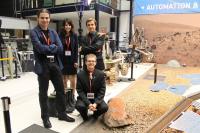Space micro organisms ”in the hands” of WUT students
Students from the Balloon Section of the Warsaw University of Technology Students’ Space Association are completing the BuLMA project (Balloon Micro Lifeform-and-Meteorite Assembler), the aim of which is to study micro organisms and meteorites in the stratosphere. In September 2015, the project was submitted to the REBUX/BEXUS campaign run by European, German and Swedish space agencies. At present, as one of several projects from Europe, it successfully completed the first stage of the competition.
BuLMA is part of the PARTICULA project, run by the students since 2013, who aim at collecting their own micro meteorites before these reach the surface of the Earth. The first device for collecting micro meteorites in space was PARTICULA 1, launched to the stratosphere on 30 June 2013. Then, young engineers improved the device and new versions of the PARTICULA project were created. The present version, PARTICULA 5, is equipped with special aerodynamic systems that absorb air from the stratosphere and collect three types of objects – micro meteorites, dust particles and micro organisms, with magnetic field (like before), electric field and organic gel (e.g. agar), later replaced with high-roughness membranes. The new device, first called μCatcher, was later renamed as BμLMA, and finally as BuLMA – Balloon Micro Lifeform-and-Meteorite Assembler – Tomasz Miś, project coordinator, says.
The BuLMA experiment will be conducted with two aerodynamic cyclones that resemble cups in which the absorbed air will be spinning. The caught particles will be pushed against the walls where they will be caught with a permanent magnet, electrodes with magnetic field and special high-roughness membranes. Then, the collected micro meteorites and dust particles, 0.1 to 0.01 millimetre small, will be studied under the microscope by the team members supported by microbiology specialists. We wish to study where they come from and what their composition is; to check how much stratospheric micro organisms differ from those that live on our planet. Also, we simply want to penetrate the secrets of the space – Paula Gajewska, member of the team, says.
The campaign REXUS/BEXUS (Rocket/Balloon Experiments for University Students) is one of the most prestigious European and global space engineering programmes for university students. In the history of the campaign, only two Polish teams managed to get to the end of the campaign and conducted their experiment; these were SCOPE 2.0 from Warsaw University of Technology (2009) and FREDE from Wrocław University of Technology (2015). Participation in this campaign not only increases the qualifications of the project members in the field of space engineering, but it also contributes to great international promotion of the university - Tomasz Miś says.
For the first time, we applied to the REXUS/BEXUS campaign with the BuLMA project in 2014. Then it was evaluated as very interesting and with great potential. However, the great number of applicants did not allow us to participate in the BEXUS 20/21 campaign. We carefully analysed the guidelines received one year earlier from the competition jury and modified the project. In December 2015, we presented an improved version of the BuLMA project and were successful – our project was accepted to the BEXUS 22/23 campaign – Paula Gajewska explains.
The Warsaw University of Technology team includes six people: Tomasz Aleksander Miś (project coordinator), Emilia Węgrzyn, Kamil Jasiński, Mateusz Płonka, Paula Gajewska and Adrian Nowakowski. If the students complete all competition stages, in October 2016, a stratospheric balloon with their experiment will be launched from the spaceport in Kiruna in the north of Sweden. The balloon will take four devices made by European students. The team members are now working on the next part of the project and preparing for the Student Training Week – workshops that will be held in Esrange Space Center of the European Space Agency in Sweden on 14-20 February 2016.








